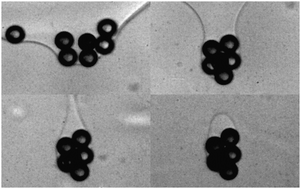Microfluidic magnetic self-assembly at liquid–liquid interfaces†
Abstract
We present a microfluidic method that controllably self-assembles microparticles into clusters at an aqueous two-phase liquid–liquid interface. The liquid–liquid interface is formed between converging flows of aqueous dextran and polyethylene glycol, in a microfluidic cross-slot device. We control the size of the self-assembled particle clusters as they pass through the liquid–liquid interface, by systematically varying the applied magnetic field gradient, and the interfacial tension of the liquid–liquid interface. We find that upon penetration through the interface, the number of particles within a cluster increases with increasing interfacial tension, and decreasing magnetic field gradient. We also develop a scaling model of the number of particles within a cluster, and observe an inverse scaling of the number of particles within a cluster with the dimensionless magnetic Bond number. Upon cluster penetration across the liquid–liquid interface, we find magnetic Bond number regimes where the fluid coating drains away from the surface of the cluster, and where the clusters are encapsulated inside a thin film coating layer. This self-assembly technique may find application in controlling the size of microscale self-assemblies, and coating such assemblies; for example, in clustering and coating of cells for immunoisolated cell transplants.


 Please wait while we load your content...
Please wait while we load your content...